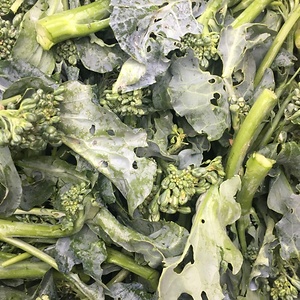


Broccoli Leaves
Estimated Inventory, bunch : 0
Description/Taste
Broccoli leaves are large, flat, and wide, averaging 15-18 centimeters long and 10-13 centimeters wide. They have a thin, fibrous central stem running throughout each leaf, ruffled edges, and have an appearance similar to collard greens. Broccoli leaves will vary slightly in color and shape depending on its variety, but the green leaf typically has dark blue-green spots with purple and grey highlights covering the surface. Broccoli leaves have a succulent, crunchy texture and mild, sweet, green flavor with a slight bitterness. They are best when harvested at a young age as they will become more fibrous and bitter with time.
Seasons/Availability
Broccoli leaves are available year-round.
Current Facts
Broccoli leaves, botanically classified as Brassica oleracea, are members of the brassica family along with cabbage, mustard, brussels sprouts, kohlrabi, and cauliflower. In 2014, Foxy Produce trademarked Broccoli leaves as BroccoLeaf. The company originally tested Broccoli leaves as a juicing green, but after discovering its versatility and positive eating qualities, the company decided to promote the leaves as the newest super green on the market. Broccoli leaves are often sold under the BroccoLeaf name in grocery stores and can be used similarly to kale, swiss chard, or collard greens.
Nutritional Value
Broccoli leaves are high in vitamin A, C, and K and also contain calcium, folate, and potassium.
Applications
Broccoli leaves are best suited for cooked applications such as baking, steaming, sautéing, and stir-frying. They can be used interchangeably in recipes that call for kale or collard greens and can be sautéed with red pepper flakes and olive oil for an easy side dish. Broccoli leaves can also be roasted and made into chips, chopped for salads, or added to stir-fries, sandwiches, and soups, and blended into green smoothies or juices. Broccoli leaves pair well with chicken, bacon, garlic, bell peppers, red pepper, onions, carrots, sundried tomatoes, legumes, potatoes, olives, fruits like citrus and berries. Broccoli leaves will keep up to two weeks when stored unwashed, in a plastic bag, and in the crisper drawer of the refrigerator.
Ethnic/Cultural Info
Broccoli leaves have seen an increase in popularity in the United States as farmers and consumers are both looking for the new "kale." Traditionally, farmers and home gardeners have used Broccoli leaves as compost to enhance the soil for other crops. However, with the growing trend of super greens and the concern of growing food waste in the United States, Broccoli leaves have grown in popularity because of their nutritional value and the ability to use the whole plant.
Geography/History
Broccoli is native to the Mediterranean and was first documented in the United States by Thomas Jefferson in 1767 when he planted it in his Monticello garden. It was not until the 1920s that it was commercially grown in the United States. Today Broccoli leaves can be found at local markets in Italy, northern Europe, and the United States in California, Oregon, Texas, and Arizona.
Recipe Ideas
Recipes that include Broccoli Leaves. One












